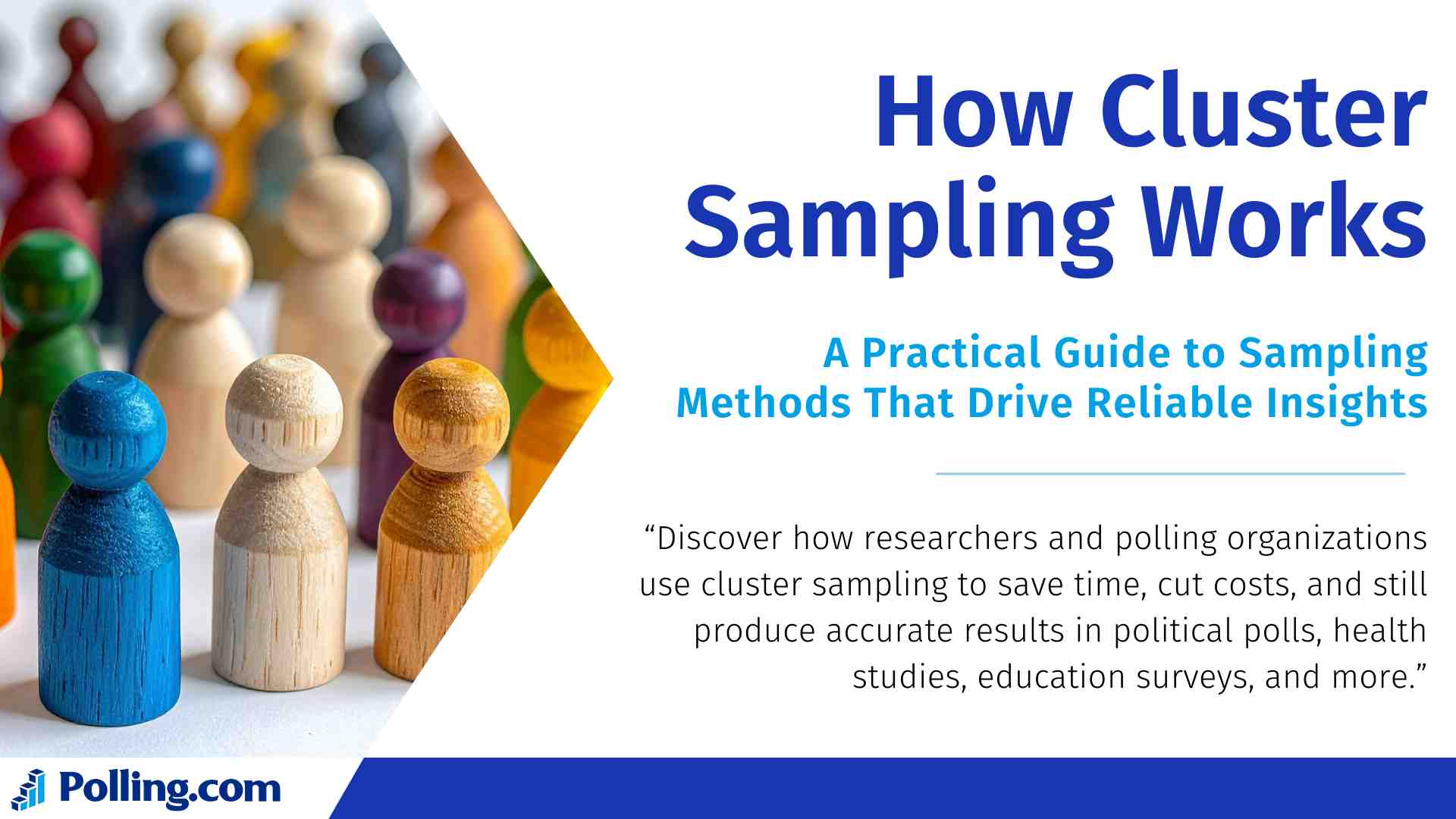
How Cluster Sampling Works & Top Use Cases in Survey & Polling
Cluster sampling is a widely used method in surveys and polls, especially when reaching every individual in a large population is difficult or costly. But what exactly is it, and why do so many researchers rely on it?
Have you ever wondered how polling organizations collect data across entire countries, even in remote areas? Or how health researchers measure vaccination rates in distant villages without surveying every resident? The answer often lies in cluster sampling.
This article will break down what cluster sampling is, how it works, and when it should be used. We’ll explore real-world examples from political polling to disaster response and show how organizations like the CDC, WHO, and Polling.com apply it in the field. Whether you’re a data analyst, student, researcher, or curious reader, this guide will help you understand the power and purpose of cluster sampling.
Foundations of Cluster Sampling
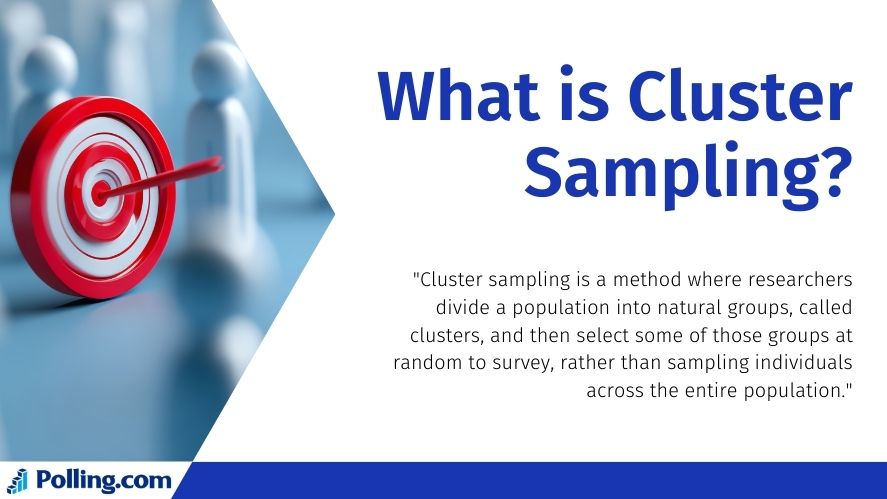
Let’s start with the basics. Cluster sampling is a method used when a population is naturally divided into groups or clusters. Instead of sampling individuals directly from the entire population, researchers select some of these clusters randomly and then study either all or a sample of individuals within those clusters.
A cluster sample definition could be: “A sampling method where entire groups (clusters) of a population are selected at random rather than individual members.”
This technique is especially useful when a full list of individuals is unavailable or when the population is spread out geographically. For example, instead of surveying every student in a country, researchers might randomly select 50 schools (clusters) and then survey students within those schools.
What is a Cluster?
A cluster can be any naturally existing group. Here are some common examples:
- Households in a village
- Schools in a city
- City blocks in a metropolitan area
- Hospitals within a district
Clusters help simplify the sampling process. Rather than hunting for individuals across vast areas, researchers focus on groups that already exist.
Why Clusters Are Used in Survey Design
Cluster sampling in surveys is often more cost-effective and practical than trying to create a complete list of individuals across a large population. It reduces travel costs, simplifies logistics, and speeds up data collection.
Key Comparisons with Other Sampling Types
Understanding how cluster sampling compares with other sampling types and techniques is essential:
Cluster Sampling vs Stratified Sampling
- Stratified sampling divides the population into non-overlapping groups (strata) based on a specific characteristic, like income level or age. Then, samples are taken from each group.
- In cluster sampling, the groups are often based on location or convenience, and entire groups are selected, not individuals across groups.
Stratified vs cluster sampling differs in how and why groups are formed. Stratified aims for balance across characteristics. Cluster focuses on practicality and efficiency.
Cluster Sampling vs Simple Random Sampling
- Simple random sampling selects individuals from the population at random.
- Cluster sampling selects entire groups at random.
While simple random sampling may provide lower sampling error, it’s often unrealistic for large or dispersed populations due to cost and logistical limitations.
When is Cluster Sampling the Best Fit?
Use cluster sampling when:
- The population is spread out geographically
- A complete list of individuals isn’t available
- You want to save time and money
- Natural groups already exist
- Field data collection is required
If these conditions match your situation, cluster sampling is likely a smart choice.
Types of Cluster Sampling
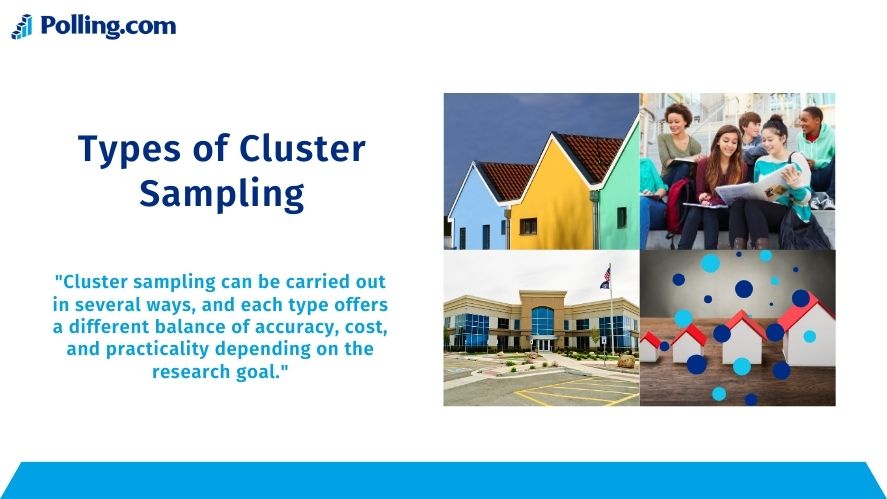
Understanding the different sampling types with examples helps researchers choose the best method for their study. Cluster sampling comes in several forms, each suited for different research goals.
Single-Stage Cluster Sampling
In this method, researchers select clusters at random and survey every individual within each selected cluster.
Example: You randomly choose 20 schools and survey all students in those schools. This is simple and fast when clusters are small and manageable.
Two-Stage Cluster Sampling
Here, clusters are randomly selected, but then individuals within those clusters are also sampled randomly.
Example: From 20 selected schools, you randomly select 30 students from each. This is useful when clusters are large and surveying everyone isn’t practical.
Multistage Cluster Sampling
This involves several stages of random selection.
Example:
- Randomly choose districts
- Within each district, randomly choose schools
- Within each school, randomly select students
This is common in large-scale health or education surveys where each layer narrows the target group.
Probability Proportional to Size (PPS)
Some clusters are larger than others. PPS sampling gives larger clusters a higher chance of being selected, making sure the sample better reflects the actual population.
Example: If one city has 1,000 people and another has 10,000, the bigger one has a 10x higher chance of being picked.
Visual Summary
Here’s a simple breakdown:
| Type | Description | Example |
|---|---|---|
| Single-Stage | Pick clusters and survey all members | Survey all households in 10 villages |
| Two-Stage | Pick clusters, then sample individuals | Survey 10 households from 20 neighborhoods |
| Multistage | Multiple rounds of selection | District → School → Student |
| PPS | Larger clusters have more chance of selection | Bigger hospitals more likely to be sampled |
Why Organizations Use Cluster Sampling
Organizations across fields choose cluster sampling because of its flexibility, cost efficiency, and practical benefits.
Cost and Logistical Efficiency
Cluster sampling reduces travel, staffing, and data collection costs. Surveying nearby individuals within a cluster is cheaper than contacting people across wide areas.
Ideal for Geographically Spread Populations
When populations are dispersed across regions or countries, cluster sampling simplifies data collection. Instead of visiting 1,000 random people scattered nationwide, researchers can focus on a few locations.
Reduces Need for Full Population Lists
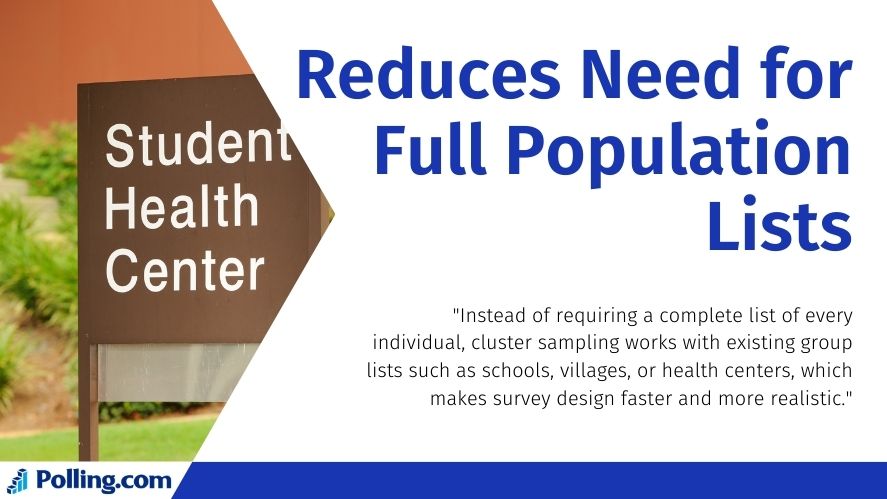
Creating a list of all individuals is often impossible. But it’s much easier to get a list of schools, villages, or health centers making cluster sampling more feasible.
Perfect for Field Surveys
For door-to-door surveys, field visits, or health assessments, cluster sampling is often the only realistic option.
Post-Disaster Assessments
Humanitarian organizations often use cluster sampling after disasters to assess needs quickly and efficiently.
These advantages make cluster sampling a go-to method in statistics sampling types especially when time, budget, and geography are constraints.
Top Use Cases in Survey & Polling
Cluster sampling plays a key role in multiple industries. Let’s explore where and why it’s used.
Political Polling
In political research, cluster sampling helps estimate opinions at the state or district level.
Use Cases:
- Pre-election surveys
- Exit polls
- Rural vs urban voting behavior
Example: A firm may randomly pick 10 voting districts per state and survey 50 residents per district.
Polling organizations often combine this with other sampling types research techniques to fine-tune predictions.
Health and Epidemiology
Health researchers use cluster sampling for disease tracking and vaccination assessments.
WHO’s 30×7 method is a famous approach:
- 30 clusters are selected randomly
- 7 individuals are surveyed per cluster
Use Cases:
- COVID-19 infection or immunity surveys
- Malaria prevalence studies
- Vaccination coverage in children
This method was critical during the pandemic for quick response efforts.
Education Surveys

In schools and universities, cluster sampling helps evaluate performance and resources.
Use Cases:
- National student achievement tests
- School-based teacher training evaluations
- Digital access surveys in rural schools
Example: Choose 50 schools at random, then test a few classrooms in each.
Consumer and Market Research
Businesses often use clusters to explore local behavior and brand perceptions.
Use Cases:
- City-level shopping habits
- Customer satisfaction by store branch
- Urban vs rural consumer behavior
Example: A company might analyze clusters based on postal codes or store locations.
Disaster Response and Humanitarian Surveys
In crises, time is short and data is vital. NGOs and relief agencies use cluster sampling to assess needs and plan aid.
Use Cases:
- Refugee camp conditions
- Emergency food or shelter needs
- Public health risks after disasters
Example: UNHCR may survey 10 clusters in a camp to estimate overall conditions.
Agriculture and Environmental Studies
Researchers use cluster sampling for field-based environmental monitoring.
Use Cases:
- Crop yield in farming districts
- Forest density measurements
- Air or water quality assessments in regions
Example: Select 30 farms in 10 counties to measure pesticide use.
Real-World Case Studies Using Cluster Sampling
To show the value of this method, let’s explore real examples across industries and countries. These cases reveal how flexible and effective this approach can be.
| COVID-19 Seroprevalence | CDC | Two-stage | Multiple U.S. States |
| Afghanistan Health Survey | WHO | Multistage | 34 provinces |
| Voter Turnout Survey | Independent Polling Firm | Single-stage | India, rural clusters |
| Consumer Goods Perception | Nielsen | Store-based clusters | Latin America |
In each case, researchers faced challenges like large areas, limited access, or lack of full population lists. Using sampling types and techniques like cluster-based designs helped collect meaningful data while managing time and cost.
For example, the CDC used two-stage sampling to understand how many people had antibodies to COVID-19. The WHO, working in Afghanistan, needed to assess healthcare access across many provinces. Both used this method to work around tough field conditions and limited resources.
Polling firms in India focused on rural voting trends. Instead of sampling across the entire nation randomly, they grouped villages and sampled voters from selected clusters. This allowed them to report insights at the regional level.
How to Design a Cluster Sampling Survey
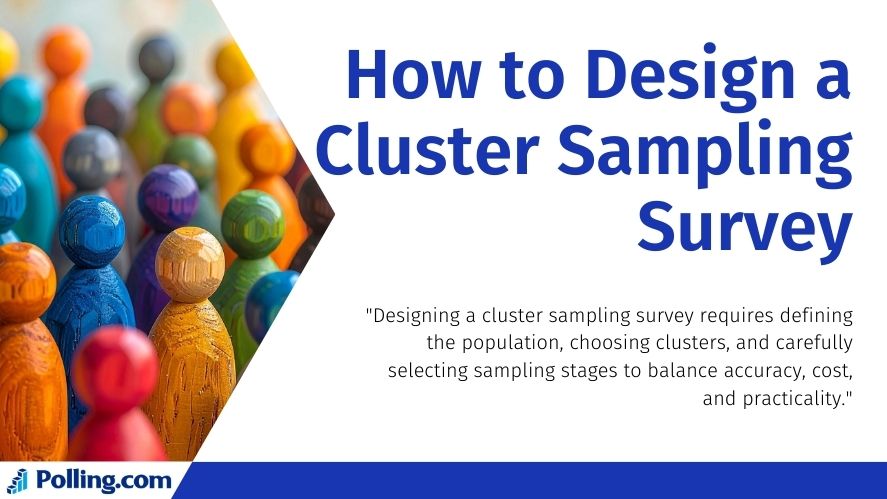
Now that we’ve seen why it works, let’s walk through how to design this kind of survey. Planning well makes all the difference.
1. Define the Population and Natural Clusters
Start by clearly defining your population. This could be:
- All school children in a state
- All patients in public hospitals
- All consumers in a country
Next, identify how the population naturally groups. Schools, hospitals, villages, districts these are all potential clusters.
2. Choose the Sampling Stages
Decide if your study will use:
- Single-stage sampling (entire clusters selected and fully surveyed)
- Two-stage sampling (select individuals within clusters)
- Multistage sampling (multiple levels, such as region > city > household)
The more complex your population, the more stages you might need.
3. Select Clusters Randomly or Use PPS
You can select clusters in two main ways:
- Simple random selection: every cluster has the same chance
- Probability proportional to size (PPS): larger clusters have higher chances
PPS is ideal when clusters vary greatly in size.
4. Sample Units Within Clusters
Once clusters are picked, select units (people, households, etc.) within those groups. This helps manage workload and reduce data collection time.
5. Calculate the Sample Size
Sampling within clusters affects how much data you need. Because individuals in the same cluster may be similar, this can increase sampling error. You’ll need to adjust your sample size using a design effect.
6. Use the Right Tools
Software like R, SPSS, or STATA helps with:
- Cluster randomization
- Weighting
- Design effect adjustments
- Sample size calculations
If you’re working with a data platform, Polling.com data sampling methods may already have these built in.
Statistical Considerations and Limitations
Like any method, this one comes with trade-offs. Understanding the math behind it helps you make better research choices.
Design Effect (Deff)
The design effect tells us how much the sampling method increases the variance of our estimates compared to simple random sampling. Clustered data often requires a larger sample size because people in the same cluster tend to be similar.
Intra-Cluster Correlation (ICC)
ICC measures how similar responses are within a cluster. High ICC means people in the same group answer alike. This affects how much new information each response adds.
For example, if students in the same school give similar answers, you may need more schools in your sample to get a balanced view.
Weighting and Adjustment
Sometimes clusters or individuals are not sampled with equal probability. To fix this, researchers apply weights. This makes the results more reflective of the full population.
Sample Size Calculations
When planning surveys, sample size must consider:
- Number of clusters
- Size of each cluster
- Expected ICC
- Desired confidence level and margin of error
Without this, you risk underpowered or misleading results.
Pros and Cons of Cluster Sampling
Let’s break down the advantages and limitations of this method.
Advantages
- Cost-effective: Fewer locations to visit, lower travel costs
- Efficient: Ideal for large or spread-out populations
- Practical: Works when complete population lists are unavailable
- Flexible: Adapts to various sectors and research needs
- Scalable: Can handle studies across towns, regions, or countries
Limitations
- Higher sampling error: More variation than other methods
- Intra-cluster similarity: Can reduce data diversity
- Advanced analysis needed: Requires adjustments and design effects
- Risk of misrepresentation: If clusters aren’t chosen well, results can be biased
Researchers must balance these trade-offs when choosing between sampling types.
When to Use Cluster Sampling (Checklist)
Wondering if this method is right for your survey? Use the checklist below.
- ✅ Is the population geographically dispersed?
- ✅ Do you lack a complete list of individuals?
- ✅ Is in-person data collection required?
- ✅ Is cost-efficiency important?
- ✅ Do clusters exist naturally (schools, hospitals, regions)?
- ✅ Can you accept slightly higher sampling error for practical gains?
If you checked most of these, this method is likely a strong fit.
FAQs About Cluster Sampling in Surveys
What’s the difference between cluster and stratified sampling?
Stratified sampling divides the population into groups based on characteristics (like age), and samples from each group. Cluster sampling groups people based on geography or structure and samples whole clusters.
Is cluster sampling good for national surveys?
Yes, especially in large countries where simple random sampling is too expensive. It allows national coverage with limited resources.
How does sample size change with cluster sampling?
You often need a larger sample size than with simple random sampling. This is due to the design effect caused by similarities within clusters.
Can cluster sampling be used in online surveys?
Yes, though it’s less common. For example, you could treat email domains or user communities as clusters. But the benefits are stronger in face-to-face or field surveys.
Looking for a Reliable Survey Platform?
If you’re planning a survey whether for public opinion, health research, or market insight and want a platform that supports expert data design, Polling.com is a top choice.
Their polling.com surveys platform simplifies sampling. You can:
- Use advanced polling.com methodology
- Choose from supported polling.com data sampling methods
- Collect, clean, and analyze data in one place
Whether you’re a beginner or a pro, Polling.com provides tools and support to help you design better surveys with trusted results.
👉 Visit Polling.com to learn more and get started.
Conclusion: When Cluster Sampling Is the Right Choice
Cluster sampling is a powerful method for collecting data when dealing with large or spread-out populations. It’s used across sectors including health, politics, education, marketing, and humanitarian response.
Let’s recap the strengths:
- Saves time and money
- Practical for field surveys
- Works when full population lists aren’t available
- Adaptable for one-stage or multistage research
But it’s not perfect. It comes with trade-offs like higher sampling error and the need for more complex analysis.
By understanding how and when to use it, you can make smarter research decisions. And with platforms like Polling.com, it’s easier than ever to apply cluster sampling effectively.
If your research meets the checklist conditions and you need to reach people across regions or groups, then this method could be exactly what you need.
